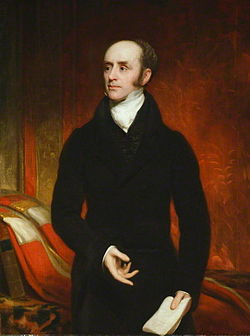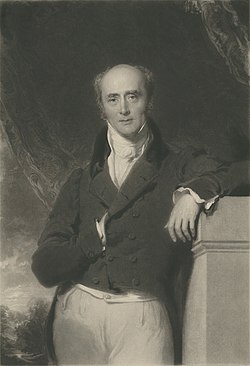Melbourne led the Government following the resignation of his predecessor in July 1834. He was dismissed in November.
The Whig government of the United Kingdom of Great Britain and Ireland that began in November 1830 and ended in November 1834 consisted of two ministries: the Grey ministry (from 1830 to July 1834) and then the first Melbourne ministry .
The first wholly Whig government since 1783 came to power after the Duke of Wellington 's Tory government lost a vote of no confidence on 15 November 1830. The government, led by the Charles Grey, 2nd Earl Grey , passed the Great Reform Act in 1832, which brought about parliamentary reform , and enacted the Slavery Abolition Act 1833 , bringing about the abolition of slavery in most of the British Empire .[citation needed
However, King William IV dismissed Grey's successor William Lamb, 2nd Viscount Melbourne in 1834 and asked Sir Robert Peel to form a government. Peel was out of the country at the time, so the Duke of Wellington formed a caretaker government .[citation needed
Portrait of Earl Grey Thomas Phillips , 1820Portrait of Henry Brougham Thomas Lawrence , 1825Portrait of the Earl of Derby Frederick Richard Say , 1844[ edit ]
Office
Name
Term
First Lord of the Treasury Leader of the House of Lords Charles Grey, 2nd Earl Grey November 1830 – July 1834
Lord Chancellor Henry Peter Brougham, 1st Baron Brougham and Vaux November 1830 – July 1834
Lord President of the Council Henry Petty-FitzMaurice, 3rd Marquess of Lansdowne November 1830 – July 1834
Lord Privy Seal John Lambton, 1st Baron Durham November 1830 – April 1833
Frederick Robinson, 1st Earl of Ripon April 1833 – June 1834
George Howard, 6th Earl of Carlisle June 1834 – July 1834
Home Secretary William Lamb, 2nd Viscount Melbourne November 1830 – July 1834
Foreign Secretary Henry John Temple, 3rd Viscount Palmerston November 1830 – July 1834
Secretary of State for War and the Colonies Frederick Robinson, 1st Viscount Goderich November 1830 – April 1833
Edward Smith-Stanley April 1833 – June 1834
Thomas Spring Rice June 1834 – July 1834
First Lord of the Admiralty Sir James Graham, 2nd Baronet November 1830 – June 1834
George Eden, 2nd Baron Auckland June – July 1834
Chancellor of the Exchequer Leader of the House of Commons John Spencer, Viscount Althorp November 1830 – July 1834
President of the Board of Control Charles Grant November 1830 – July 1834
Chief Secretary for Ireland Edward Smith-Stanley June 1831 – March 1833
Postmaster-General Charles Gordon-Lennox, 5th Duke of Richmond December 1830 – July 1834
Chancellor of the Duchy of Lancaster Henry Richard Vassall-Fox, 3rd Baron Holland November 1830 – July 1834
Paymaster of the Forces Lord John Russell June 1831 – July 1834
Secretary at War Edward Ellice June – July 1834
Minister without Portfolio George Howard, 6th Earl of Carlisle November 1830 – June 1834
[ edit ] Portrait of Lord Melbourne John Partridge , 1844
Office
Name
Term
First Lord of the Treasury Leader of the House of Lords William Lamb, 2nd Viscount Melbourne July–November 1834
Lord Chancellor Henry Peter Brougham, 1st Baron Brougham and Vaux July–November 1834
Lord President of the Council Henry Petty-FitzMaurice, 3rd Marquess of Lansdowne July–November 1834
Lord Privy Seal Constantine Phipps, 2nd Earl of Mulgrave July–November 1834
Home Secretary John Ponsonby, Viscount Duncannon July–November 1834
Foreign Secretary Henry John Temple, 3rd Viscount Palmerston July–November 1834
Secretary of State for War and the Colonies Thomas Spring Rice July–November 1834
First Lord of the Admiralty George Eden, 2nd Baron Auckland July–November 1834
Chancellor of the Exchequer Leader of the House of Commons John Spencer, Viscount Althorp July–November 1834
President of the Board of Trade Treasurer of the Navy Charles Poulett Thomson July–November 1834
President of the Board of Control Charles Grant July–November 1834
Master of the Mint James Abercromby July–November 1834
First Commissioner of Woods and Forests Sir John Hobhouse, 2nd Baronet July–November 1834
Chancellor of the Duchy of Lancaster Henry Richard Vassall-Fox, 3rd Baron Holland July–November 1834
Paymaster of the Forces Lord John Russell July–November 1834
Secretary at War Edward Ellice July–November 1834
Members of the Cabinet are indicated by bold face.
Notes
^ The government resigned 8 May 1832 and resumed 17 May 1832.
^ Also Leader of the House of Commons until 1834.
^ Created Earl of Durham 23 March 1833.
^ a b Joint Secretary from 22 April 1834.
^ Entered the Cabinet 16 June 1831.
^ Entered the Cabinet 16 June 1831; also Leader of the House of Commons 1834.
^ entered the Cabinet 20 June 1834.
^ Office renamed Captain of the Gentlemen-at-Arms 17 March 1834.
^ Created Earl of Lichfield 15 September 1831.
C. Cook and B. Keith, British Historical Facts 1830–1900
 From Wikipedia - Reading time: 9 min
From Wikipedia - Reading time: 9 min




 KSF
KSF

